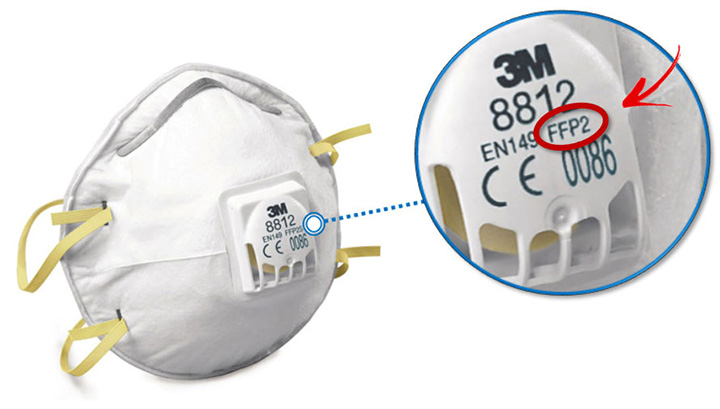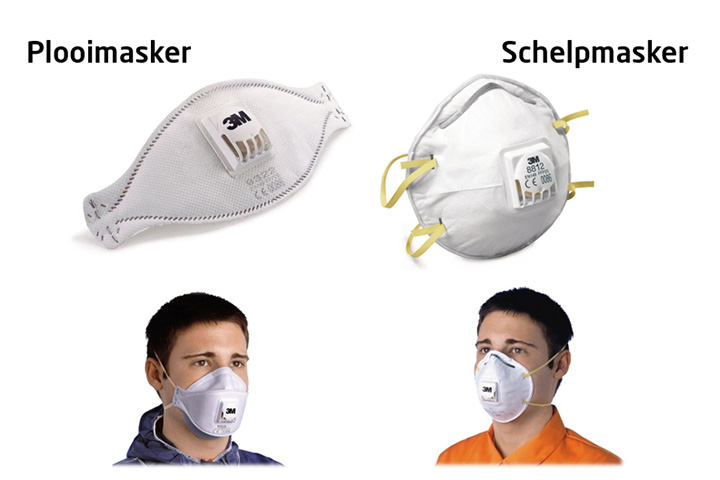On average, we breathe in and out 20 000 times a day. That is about 6 600 times during working hours. Anyone working in an environment with a lot of dust or fine particles is therefore best to wear a mouth or dust mask. Dust masks are classified according to the FFP class: this is a measure of the filtering capacity of the mask. Read on and learn how to choose the right mouth mask for your profession.
► Step 1: What is the FFP class of a dust mask?
The code FFP stands for Filtering Facepiece Particals. It indicates the way your dust mask filters the air. You can think of the filter as a sieve full of holes. The smaller those holes, the finer the particles that are filtered. The disadvantage of a very good filter is that the holes through which you have to breathe are so small that you have to put more effort into breathing. We distinguish three levels of FFP, from a low to a high filter level:
| FFP class |
Filter level |
Application |
| . FFP1 |
► Protects against harmless smoke/dust/mist ► Filter capacity 78% For example: cotton or wood particles, graphite, ferrous metals, calcium carbonate, hay, etc. |
Construction industry, food industry . |
| . FFP2 |
Protects against irritant smoke/dust/mist ► Filter capacity 92% For example: residual particles of metal, resin and glass wool, seeds and mushrooms, flour dust, etc. |
Construction industry, chemical industry, metal industry, shipbuilding . |
| . FFP3 |
Protects against toxic smoke/dust/mist ► Filter capacity 98% For example: ceramic fibre, rock wool, cadmium, chromium, etc. |
Chemical industry, pharmaceutical industry, metal industry, shipbuilding. |

► Step 2: What do the additional letters on my mouthguard mean?
You can sometimes find these letters before or after the FFP class of your mask:
| Additional designation | Meaning |
| D (Dolomite test) |
This durability test indicates that the filter does not clog too quickly. The mask may therefore be used several times within the same working day. |
| R/NR (Reusable/Non-reusable) |
A mask marked “reusable”has a sealing ring on the inside of the mask. This seal allows the mask to be cleaned and reused the very next day. |
| V (Valve) |
A ‘valve’ or exhalation valve reduces exhalation resistance and reduces CO2 content, humidity and temperature inside the mask. |
► Step 3: Pleated mask or shell mask?
A shell mask always retains its shape and is often slightly cheaper to buy. A pleated mask, on the other hand, is more comfortable as it fits better around your face. A pleated mask is also easy to fold and store in your pocket.

► Step 4: Dust mask with or without valve?
With a dust mask without a valve, the filter saturates fastest. Dust masks with exhalation valve last longer. The valve has a check valve: when inhaling, the valve closes; when exhaling, the valve opens. This allows CO2 to escape from your mask more easily, making the filter last longer.
The valve keeps the mask cool and dry for longer on the inside. This is much more pleasant when wearing it for long periods of time. If you wear safety goggles at the same time, they will catch on less because less moist air escapes.
 ]
]
- Pleated dust masks marked V (or Valve/Valve) guarantee increased wearing comfort.
- A dust mask only protects against dust, not paint or gases.
- Taking a break? Then put your mask down with the open side (i.e. the side facing your face) down. This way, no harmful dust can swirl in.
- When is a dust mask saturated? A dust mask is due for replacement when:
- Inhalation resistance increases.
- You taste or smell the ambient dust














